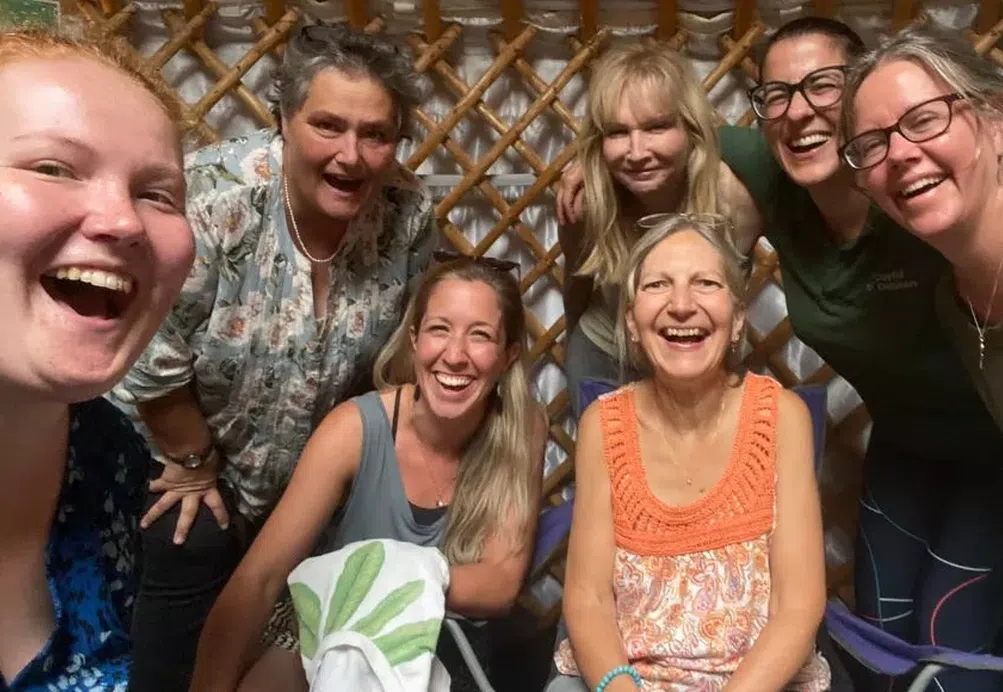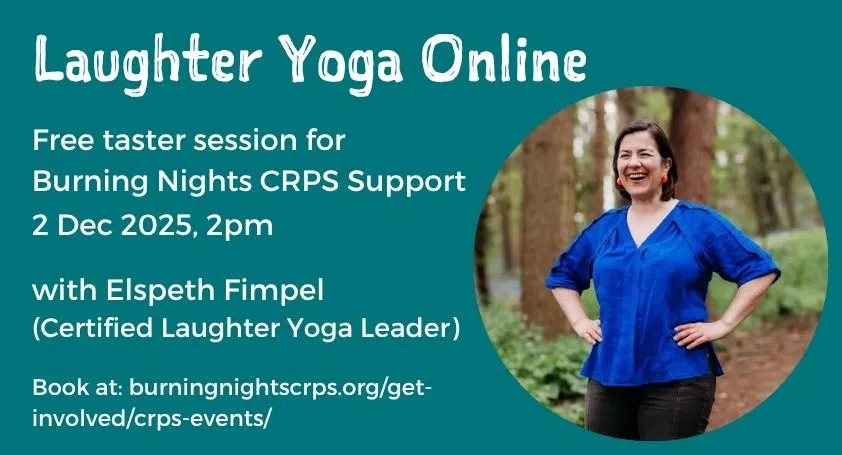We use cookies to improve your experience. By accepting you agree to our cookie policy


Think back to those moments at school when a friend caught your eye and the giggles took over – unstoppable, breathless, tears-streaming laughter. The kind that leaves you gasping, snorting, clutching your sides. Until it finally eases into a long, deep breath and a sense of lightness.
If only that feeling could be bottled.
Perhaps it can? Or at least you can learn to tap into that same energy whenever you need it.
This is what Elspeth Fimpel of Joyful Outdoors helps people do in her laughter yoga workshops.
"Laughter yoga is about practising intentional laughter.
It's not waiting for something to be funny – it's choosing to laugh because you can."
When Complex Regional Pain Syndrome (CRPS) and chronic pain are part of your life, laughter can feel distant, unachievable and irrelevant to your everyday reality.
But there’s a reason they say laughter is the best medicine.
As soon as you laugh, adrenaline levels drop and your body begins to relax. You’ll experience a reduction in the stress hormone cortisol and a flood of endorphins, the body’s natural painkiller [1,2].
Laughter helps us feel safe and connected to those around us. It fills our lungs with oxygen [3] and engages the whole body – a full belly-laugh is a workout in itself.
Laughter yoga was developed in 1995 by Indian physician Dr Madan Kataria. It combines gentle movement and yoga-based breathing techniques with laughter exercises – no headstands or tricky stretches necessary! Most importantly it offers space to focus on laughter itself, without relying on jokes or comedy.
Of course you don’t need a workshop to laugh. But when we’re weighed down and buttoned up by the worries of daily life, laughter can be hard to find. Laughter yoga is a chance to set those worries aside for a while and give yourself permission to let go. It’s also a social experience – you're 30 times more likely to laugh with others than on your own [4].
"Laughter yoga creates space to be silly and a chance to be playful.
It's about making noise and taking up space. And giving yourself permission to do so."
Laughter yoga is a flexible practice. There are no prescribed movements – you do what feels comfortable within the flow of the session.
Elspeth adapts to the energy and needs of each group but expect:
Wear whatever is comfortable – people join sessions in everything from gym gear to summer dresses. It’s about what feels good for you.
"It doesn't matter if you start with a fake laugh – your body still feels the benefits," says Elspeth.
"And when you're surrounded by laughter, it won't stay fake for long!"
Studies suggest that self-induced laughter triggers similar positive responses in the body to spontaneous laughter [5].
And, whether it’s real or fake, laughter is contagious.
You might begin a laughter yoga class pretending, but fake laughter will quickly escalate into genuine giggles.
Most people feel awkward at first, but Elspeth is used to ‘breaking through the discomfort barrier’.
She creates a safe, relaxed environment and always has a few exercises ready to shake off self-consciousness.
"You do have to commit and allow yourself to let go," she says.
"But once you do, it's worth it."
If you start to worry about being silly, Elspeth is there as an anchor for the group, reassuring and joyfully committed to loud, whole-hearted laughter.
While research is still limited, existing studies support the benefits of laughter yoga in managing conditions ranging from depression to cancer recovery [6,7].
It’s not a magic pill – everyone’s experience of chronic pain and CRPS is different – but as Elspeth is keen to remind us,
“don’t we just know that laughter makes us feel good?”
The beauty of laughter yoga lies in its simplicity and accessibility. Anyone can take part, regardless of age, ability or fitness level. There’s no ‘wrong’ way to do it.
Sessions also create lasting emotional memories that can be drawn upon in challenging times. One regular participant in Elspeth’s classes recalls the feeling of laughing together to calm the nightmares brought on by cancer treatment.
“The more you laugh, the easier it is to access that feeling.”
Tapping into your own energy – without relying on comedy or external triggers – gifts you mental and emotional freedom.
“I love laughter yoga because I can see the impact it has on people,” says Elspeth.
“It makes me feel better too. What's not to love?”
Join Elspeth for an exclusive online laughter yoga session with Burning Nights CRPS Support on Tuesday 2 December 2025.
Elspeth is a certified laughter yoga practitioner who has led sessions everywhere from a yurt at Glastonbury to a care home and even in a shopping centre. To find out more about her workshops visit Joyful Outdoors.
For other Burning Nights CRPS Support events, keep an eye on our online calendar.

We use cookies to improve your experience. By accepting you agree to our cookie policy
 £
£